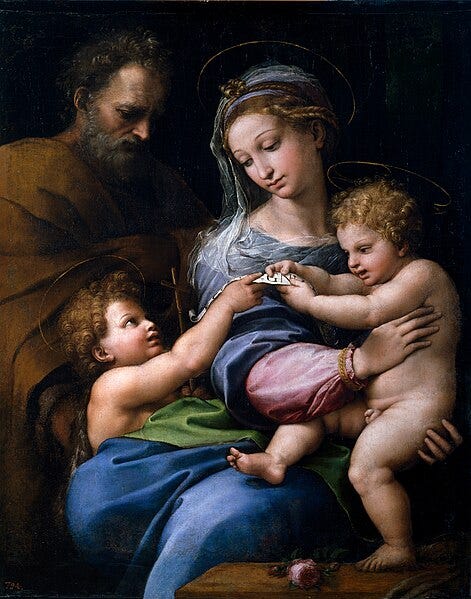Researchers have published a study in which they used AI to perform a detailed analysis of Raphael’s Madonna della Rosa to discern whether Raphael painted all of it or just some of it.
Spoiler alert: He just did the good parts. Joseph was an afterthought (again), added by someone else when Raphael was at lunch.
Raffaello Santi - Madonna della Rosa (Prado), 1517, a collaboration by Raphael and the pizza delivery guy.
The breakthrough here is the specific combination of deep learning for feature extraction and traditional machine learning for classification. Up until now, computational methods for artwork analysis have mostly been about Digital Imaging Techniques (X-ray, infrared reflectography, and UV fluorescence to examine underdrawings, layers of paint, and restorations; Spectroscopic Analysis (to provide information on the materials and pigments used); and Statistical and Computational Analysis (basic pattern recognition and statistical analysis). Don’t be impressed, I looked all that up.
Also thinking about what metadata means when applied to analogue artifacts. Information that informs an understanding of a painting includes provenance (history of ownership), attribution (who got the credit), catalogues, condition reports, exhibition histories, scholarly annotations, or other historical documentation (traces of analysis found in archives), and inscriptions (markings on the back).
Of course digital forms also contain (nay, invented!) metadata: Software and hardware already record a vast array of information, potentially including things like title, genre, authorship, copyright, colour profiles embedded within an image, information about camera settings like aperture, resolution, focal length, shutter speed, ISO sensitivity, camera make and model, and the timestamp and geographical coordinates where an image was created. You can also add keywords, captions, comments, or whatever else to metadata in various formats.
But where art historical research sometimes looks to habit or process of the artist when trying to identify factors that make it more or less likely that something was painted by a specific person, I don’t think digital forms have that, yet (?!).
For example when trying to identify an authentic Raphael, they’d look to the colour of Raphael’s usual primer (is it really his kind of yellowish?), whether it seems like a forger used some weird pencil or pen, whether they started the whole thing with transparent brown and put the final colours on top while the draft marks were still visible, etc.
But what would it look like for a digital artwork to contain each and every keystroke, action, tool, or adjustment that went into its creation? Will art historians in 500 years be looking at a Nicolas Sassoon and saying “Since Sassoon was known to harden pixel lines prior to layering in his distinctive moire patterns in the now defunct Photoshop V 23.5, this artifact is clearly made by one of the many art forging nations that have come to us in recent years from outer space.”




Guess that's why he's in the dark.